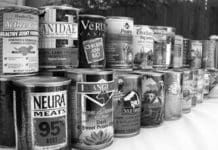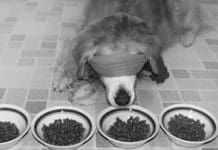Best Food Grinders Used For Home-Prepared Dog Food Diets
People who are interested in feeding a home-prepared diet to their dogs often delay the transition as they grapple with various concerns. Frequently, they have come to believe the claims that a home-prepared diet offers dogs superior nutrition and can result in increased health and vigor . . . but they are still beset by fears that their dogs will suffer a broken tooth or perforated intestines caused by eating raw bone fragments.
Dog Food Manufacturers and The Food Labeling Skepticisms
Frequently, we hear things about dog food companies that would curl your hair. And rarely, if ever, can we print anything we hear, because much of it is unverifiable and perhaps even untrue – lies made up or part-truths distorted by unhappy consumers or unscrupulous competitors. We take this stuff with a grain of salt.
Whole Dog Journal’s 2002 Canned Dog Food Review
and accordingly
Veterinarian-Prescribed Dog Foods
An examination of veterinarian-prescribed dog foods that purport to prevent or treat disease, and over-the-counter foods that promise to "promote" improved health. Medical diets are the ones formulated for dogs with health problems, from vexing but garden-variety conditions such as itchy skin or digestive issues, to more serious health problems such as cancer or kidney disease. Some of these foods are what we'll call veterinary diets" (available only from veterinarians); the rest are over-the-counter (OTC) products
The Evolution of the Raw Dog Food Diet
Canines have eaten raw for a whole lot longer than they've eaten cooked foods! It's difficult for us to understand, in the face of this one fact, how any dog guardians (much less thousands of veterinarians) could deny that raw food diets are healthful for dogs. But is it really best for ALL dogs? Actually, there are exceptions.
Sugar in Dog Treats
Dogs generally like sugar, which occurs naturally in certain foods, including fruit, milk, and vegetables. When dealing with anything that dogs eat, our bias is toward natural, whole foods, rather than artificial or highly processed ingredients. We'd rather see a dog eat a strawberry, for example, than a treat with an artificial strawberry-flavored, artificially sweetened treat. This may be an unscientific, instinctive response, but dogs (and people) have been eating real foods a lot longer than they have been eating artificial foods; we trust real foods more.
Frozen Dog Treat Review
We found only four commercial products intended as hot-weather treats – though, truthfully, this was a bit of a reach. Only one product is an actual frozen treat, purchased in grocery stores or pet supply stores equipped with freezers (many stores that sell top-quality frozen raw dog foods also sell this treat). Two other products are sold in a form similar to pre-made Jello or pudding cups: edible in that form, but intended to be frozen or refrigerated and eaten cold. The fourth product actually is ice cream – freeze dried and meant to be fed in small, not cold pieces. This product niche could use a few more contestants!
Commercial Dog Food or Homemade?
Everyone who cares about their dogs wants to feed them good food." By and large
A Special Food for Every Dog?
When it comes to choosing a dog food, the number of choices currently found on the shelves is nearly overwhelming. Thanks to niche marketing – a position from which an opening in a market can be exploited, or a specialized but profitable segment of a commercial market – the production of dog foods is following the trend in human products for increasing specialization. There really is something for everyone: big dogs; medium dogs; small dogs; working dogs; dogs with tender tummies, stinky breath, or itchy feet; couch potatoes and elite athletes – all dogs can get a diet specifically designed just for them.
More On Frozen Foods!
50808
Frozen Raw Meat-Based Dog Food Diets
There are thousands of dog guardians who feed their dogs homemade BARF-based diets, buying all the ingredients and preparing their dogs’ meals from scratch. People who utilize home-prepared diets are happy to discuss the many benefits of this feeding method for their dogs, including clean, tartar-free teeth; fresh breath; strong bones, muscles, and joints; a glossy coat; a healthy amount of energy and a balanced temperament; and overall vibrant good health. For all the people who have made the leap to a homemade, meat-based diet for their dogs, however, there are many more who would like to make the change, but who are intimidated by the challenge of “getting it just right.” Some are afraid of failing to present their dogs with a balanced array of nutrients; others fear bacterial contamination from handling raw meats.
Letters 04/02: Let’s Talk About Food!
it will always do so unless its ingredients have changed.
----------
I was dismayed that [the food I use] did not make your list. Can you look at the enclosed label and tell me what you think of it?
Our lists of foods contain only some foods that meet our selection criteria; with thousands of foods on the market (some available only in one state or area of the country)












